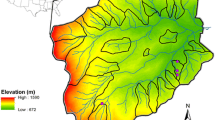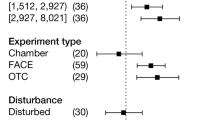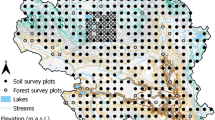Abstract
A general model of ecosystem biogeochemistry was used to examine the responses of arctic tundra and temperate hardwood forests to a doubling of CO2 concentration and to a 5°C increase in average growing season temperature. The amount of C stored in both ecosystems increased with both increased CO2 and temperature. Under increased CO2, the increase in C storage was due to increases in the C∶N ratio of both vegetation and soils. Under increased temperature, the increased C storage in the forest was due to a shift in N from soils (with low C∶N ratios) to vegetation (with high C∶N ratios). In the tundra, both a shift in N from soils to vegetation and an increase in C∶N ratios contributed to increased C storage under higher temperatures. Neither ecosystem sequestered N from external sources because the supply rate was low.
Similar content being viewed by others
References
Aber, J.D., J.M. Melillo, C.A. McClaugherty, and K.N. Eshleman. 1983. Potential sinks for mineralized nitrogen following disturbance in forest ecosystems. Ecological Bulletins (Stockholm) 35: 179–192.
Aber, J. D., J. M. Melillo, K. J. Nadelhoffer, J. Pastor, and R. D. Boone. 1991. Factors controlling nitrogen cycling and nitrogen saturation in northern temperate forest ecosystems. Ecological Applications 1:303–315.
Aerts, R., and F. Berendse. 1989. An analysis of competition in heathland ecosystems. I. Competition for nutrients. Chapter 9 in R. Aerts (ed.) Plant Strategies and Nutrient Cycling in Heathland Ecosystems. Foundation for Fundamental Biological Research, Netherlands Organization for Scientific Research, The Netherlands.
Anderson, D.W. 1988. The effect of parent material and soil development on nutrient cycling in temperate ecosystems. Biogeochemistry 5:71–97.
Anderson, J.M. 1991. The effects of climate change on decomposition processes in grassland and coniferous forests. Ecological Applications 1:326–347.
Bazzaz, F.A. 1990. The response of natural ecosystems to the rising global CO2 levels. Annual Reviews of Ecology and Systematics 21:167–196.
Berendse, F. 1990. Organic matter accumulation during secondary succession in heathland ecosystems. Journal of Ecology 8:413–427.
Berendse, F., H. Oudhof, and J. Bol. 1987. A comparative study on nutrient cycling in wet heathland ecosystems. Oecologia (Berlin) 74:174–184.
Berendse, F.-, R. Robbink, and G. Rouwenhorst. 1989. A comparative study on nutrient cycling in wet heathland ecosystems: II. Litter decomposition and nutrient mineralization. Oecologia 78:338–348.
Billings, W. D., J. O. Luken, D. A. Mortensen and K. M. Peterson. 1982. Arctic tundra: A source or sink for atmospheric carbon dioxide in a changing environment? Oecologia 53:7–11.
Billings, W. D., K. M. Peterson, J. O. Luken and D. A. Mortensen. 1984. Interaction of increasing atmospheric carbon dioxide and soil nitrogen on the carbon balance of tundra microcosms. Oecologia 65:26–29.
Bolin, B. and R. B. Cook (eds). 1983. The Major Biogeochemical Cycles and Their Interactions. John Wiley and Sons, Chichester, 532 pp.
Bormann, F. H., and G. E. Likens. 1979. Pattern and Process in a Forested Ecosystem. Springer-Verlag, New York.
Chapin, F. S. III, P. C. Miller, W. D. Billings, and P. I. Coyne 1980. Carbon and nutrient budgets and their control in coastal tundra. Pages 458–484 in J. Brown, P. C. Miller, L. Tieszen, and F. L. Bunnell (eds.) An Arctic Ecosystem: The Coastal Tundra at Barrow Alaska. Dowden, Hutchinson, and Ross. Stroudsburg, PA.
Chapin, F. S. III, and G. R. Shaver. 1985. The physiological ecology of arctic plants. Pages 16–40 in B. Chabot and H. A. Mooney (eds.), Physiological Ecology of North American Plant Communities. Chapman and Hall, London.
Drake, B. G., P. W. Leadly, W. Arp, P. S. Curtis, and D. Whigham. 1989. The effect of elevated atmospheric CO2 on C3 and C4 vegetation on Chesapeake Bay. Proceedings of the Symposium on the Physiological Ecology of Aquatic Plants. Aarhus, Denmark.
Fisher, S., L. Gray, N. Grimm and D. Busch. 1982. Temporal succession in a desert stream ecosystem following flash flooding. Ecol. Monogr 52:93–110.
Gates, D. M. 1985. Global biospheric response to increased atmospheric carbon dioxide concentration. Pages 174–184 in B. R. Strain and J. D. Cure (eds), Direct Effects of Increased Carbon Dioxide on Vegetation. U. S. Dept. Energy, Washington D. C.
Giblin, A.E., K.J. Nadelhoffer, G.R. Shaver, J.A. Laundre, and A.J. McKerrow. 1991. Biogeochemical diversity along a riverside toposequence in Arctic Alaska. Ecological Monographs 61 (4):415–435.
Hobbie, J. E., J. Cole, J. Dungan, R. A. Houghton, and B. Peterson. 1984. Role of biota in global CO2 balance: The controversy. BioScience 34:492–498.
Idso, S. B. 1986. Industrial age leading to the greening of the earth? Nature 320:22.
Idso, S. B. 1989. Carbon dioxide, soil moisture, and future crop production. Soil Science 147:305–307.
Kramer, P. J. 1981. Carbon dioxide concentration, photosynthesis, and dry matter production. BioScience 31:29–33.
McClaugherty, C. A., J. D. Aber, and J. M. Melillo. 1982. The role of fine roots in the organic matter and nitrogen budgets of two forested ecosystems. Ecology 63:1481–1490.
Melillo, J. M., T. V. Callaghan, F. I. Woodward, E. Salati, and S. K. Sinha. 1990. Effects on Ecosystems. Pages 282–310 in J. T. Houghton, G. J. Jenkins, and J. J. Ephraums (eds), Climate Change: the IPCC Scientific Assessment. Cambridge University Press, Cambridge.
Melillo, J. M., and J. R. Gosz. 1983. Interactions of the biogeochemical cycles in forest ecosystems. Pages 177–222 in B. Bolin and R. B. Cook (eds) The Major Biogeochemical Cycles and Their Interactions. John Wiley and Sons, New York.
Mitchell, H. L. and R. F. Chandler. 1939. The nitrogen nutrition and growth of certain deciduous trees of the northeastern United States. Black Rock Forest Bull. 11.
Parton, W.J., J. W. B. Stewart, and C. V. Cole. 1988. Dynamics of C, N, P, and S in grassland soils: A model. Biogeochemistry 5:109–131.
Peterson, B. J., and J. M. Melillo. 1985. The potential storage of carbon caused by eutrophication of the biosphere. Tellus 37B:117–127.
Raich, J. W., E. B. Rastetter, J. M. Melillo, D. W. Kicklighter, P. A. Steudler, B. J. Peterson, A. L. Grace, B. Moore, and C. J. Vorosmarty. 1991. Potential net primary productivity in South America: Application of a global model. Ecological Applications 1:399–429.
Rastetter, E. B., M. G. Ryan, G. R. Shaver, J. M. Melillo, K. J. Nadelhoffer, J. E. Hobbie, and J. D. Aber. 1991. A general model describing the responses of the C and N cycles in terrestrial ecosystems to changes in CO2, climate, and N deposition. Tree Physiology 9:101–126.
Rastetter, E. B., and G. R. Shaver. 1992. A model of multiple element limitation for acclimating vegetation. Ecology 73, in press.
Shaver, G. R., W. D. Billings, F. S. Chapin, A. E. Giblin, K. J. Nadelhoffer, W. C. Oechel, and E. B. Rastetter. 1992. Global change and the carbon balance of arctic ecosystems. BioScience, in press.
Shaver, G.R. and F.S. Chapin, III. 1991. Production:biomass relationships and element cycling in contrasting arctic vegetation types. Ecological Monographs 61 (1):1–31.
Shaver, G. R., F. S. Chapin, and B. L. Gartner. 1986. Factors limiting seasonal growth and peak biomass accumulation in Eriophorum vaginatum in Alaskan tussock tundra. Journal of Ecology 74:257–278.
Shaver, G.R., K.J. Nadelhoffer, and A.E. Giblin. 1990. Biogeochemical diversity and element transport in a heterogeneous landscape, the North Slope of Alaska. Pages 105–125 in M.G. Turner and R.H. Gardner (eds.), Quantitative Methods in Landscape Ecology. Springer-Verlag, New York, New York, USA.
Strain, B. R., and F. A. Bazzaz. 1983. Terrestrial plant communities. Pages 177–222 in E. R. Lemon (ed), CO2, and Plants: The response of Plants to Rising Levels of Atmospheric Carbon Dioxide. Westview Press, Boulder
Strain, B. R., and J. D. Cure (eds). 1985. Direct Effects of Increasing Carbon Dioxide on Vegetation. U. S. Dept. Energy, Washington D.C.
Strain, B. R., and J. D. Cure. 1986. Direct Effects of Atmospheric CO2 Enrichment on Plants and Ecosystems: A Bibliography with Abstracts. U. S. Dept. Energy, Washington D.C.
Tans, P. P., I. Y. Fung, and T. Takahashi. 1990. Latitudinal distribution of sources and sinks of atmospheric carbon dioxide. J. Geophys. Res. 94:5151–5172.
Tissue, D.T., and W.C. Oechel. 1987. Response of Eriophorum vaginatum to elevated CO2 and temperature in the Alaskan tussock tundra. Ecology 68:401–410.
Vitousek, P., T. Fahey, D. Johnson and M. Swift. 1988. Element interactions in forest ecosystems: Succession, allometry and inputoutput budgets. Biogeochemistry 5:7–34.
Vitousek, P. M. and W. A. Reiners. 1975. Ecosystem succession and nutrient retention: A hypothesis. BioScience 25:376–381.
Author information
Authors and Affiliations
Rights and permissions
About this article
Cite this article
Rastetter, E.B., McKANE, R.B., Shaver, G.R. et al. Changes in C storage by terrestrial ecosystems: How C-N interactions restrict responses to CO2 and temperature. Water Air Soil Pollut 64, 327–344 (1992). https://doi.org/10.1007/BF00477109
Issue Date:
DOI: https://doi.org/10.1007/BF00477109




